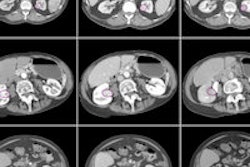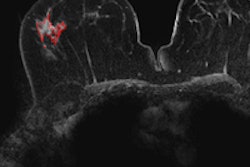False-positive results are an unfortunate aspect of mammography. But an algorithm that analyzes the texture of breast tissue on mammograms may be able to predict which patients are more likely to have negative biopsy results, paving the way for more individualized screening, according to researchers from the University of Pennsylvania.
In a retrospective analysis, a team from the university's Computational Breast Imaging Group found that its texture analysis algorithm yielded 51% sensitivity for predicting false positives while operating at a 100% cancer detection setting. The researchers presented their findings in a poster at the recent SPIE Medical Imaging 2014 conference in San Diego.
"We feel that this preliminary study shows that computer-based features of breast complexity through the locally adaptive texture analysis has the potential to improve the prediction likelihood of false-positive recall from routine screening mammography," first author Shonket Ray, PhD, told AuntMinnie.com. "Ideally, new prediction models could incorporate these texture features to help identify women at high risk for false-positive mammograms and, ultimately, help guide better-tailored screening models."
False-positive mammography findings are common during breast cancer screening and diagnosis, with a majority of women receiving at least one false-positive result and 7% to 9% receiving a false-positive biopsy recommendation during their lifetime, according to the researchers.
"[False-positive] biopsies can lead to unnecessary physical pain, scarring, and psychological trauma, as well as heavily contributing to breast cancer screening programs," the authors wrote in the presented poster.
Mammographic texture analysis may offer some hope of improving this situation. While breast density is a strong risk factor for breast cancer, it's a global-based feature. In contrast, mammographic texture offers a more individual view by enabling quantification of spatial distribution of parenchymal tissue characteristics, as well as analysis of more subtle, localized parenchymal texture patterns, according to the researchers.
"Previous studies have shown that further examination of parenchymal texture features could provide complementary information about breast cancer risk in conjunction with mammographic percent density, a known strong risk factor," Ray said.
Adaptive texture analysis
As a result, the group developed and tested a locally adaptive texture analysis algorithm that quantifies parenchymal tissue complexity to yield objective and reproducible thresholds for predicting the risk of false-positive biopsies. The algorithm allows for adaptive region-of-interest (ROI) selection based on the spatial distribution and parenchymal tissue patterns of a specific digital mammogram, according to the group.
"Texture patterns are first locally extracted to capture subtle, localized parenchymal texture patterns and then combined to represent global pattern characteristics," they wrote. "By adaptively focusing on localized tissue characteristics, we could provide more discriminating and patient-specific information for accurate false-positive risk prediction."
Current methods compute parenchymal texture features from a single ROI typically placed manually within the breast, either in the retroareolar area or in the central breast area, Ray explained.
"We feel that the texture features produced from these methods are limited in that they do not fully capture the heterogeneity of the parenchymal texture found in the entire breast," he said. "Our algorithm was designed to help alleviate this major issue."
The algorithm was evaluated retrospectively on a set of digital mammography images from the American College of Radiology Imaging Network (ACRIN) PA 4006 trial. This sample included 69 women who were recalled based on digital mammography results. Of these 69, 11 were true positives and 59 were benign or high-risk lesions (false positives).
A Selenia (Hologic) full-field digital mammography unit was used to acquire bilateral craniocaudal and mediolateral oblique views. The postprocessed images were at 70-micron resolution using 12-bit gray-level depth.
Significant predictors
The algorithm computed an individual mean feature for each corresponding texture feature over all selected ROIs. For each woman, a total of 13 mean texture features were calculated, including energy, correlation, entropy, contrast, inverse difference moment, sum average, sum variance, sum entropy, difference average, difference variance, difference entropy, information measure of correlation 1, and information measure of correlation 2.
Logistic regression analysis was performed to assess which of these features were significant predictors of false-positive recalls, adjusting for age and the number of previous benign biopsies. The researchers found that only contrast, sum variance, and difference average were statistically significant (p < 0.05) for predicting risk of false-positive recall.
Receiver operator characteristics (ROC) analysis showed that the algorithm yielded a sensitivity of 51% for predicting false positives at a 100% cancer detection operating point.
Along with fine-tuning the parameters used by the algorithm and optimizing its overall ROI extraction accuracy, the researchers are now assessing which particular parenchymal texture features perform the best.
"We plan to combine these with breast percent density and other relevant epidemiological factors to develop a new comprehensive descriptor," Ray said. "The predictive value of this descriptor would be optimized in terms of improving individual breast cancer risk estimation from screening and assessing the risk of false-positive or false-negative screening exams."




















